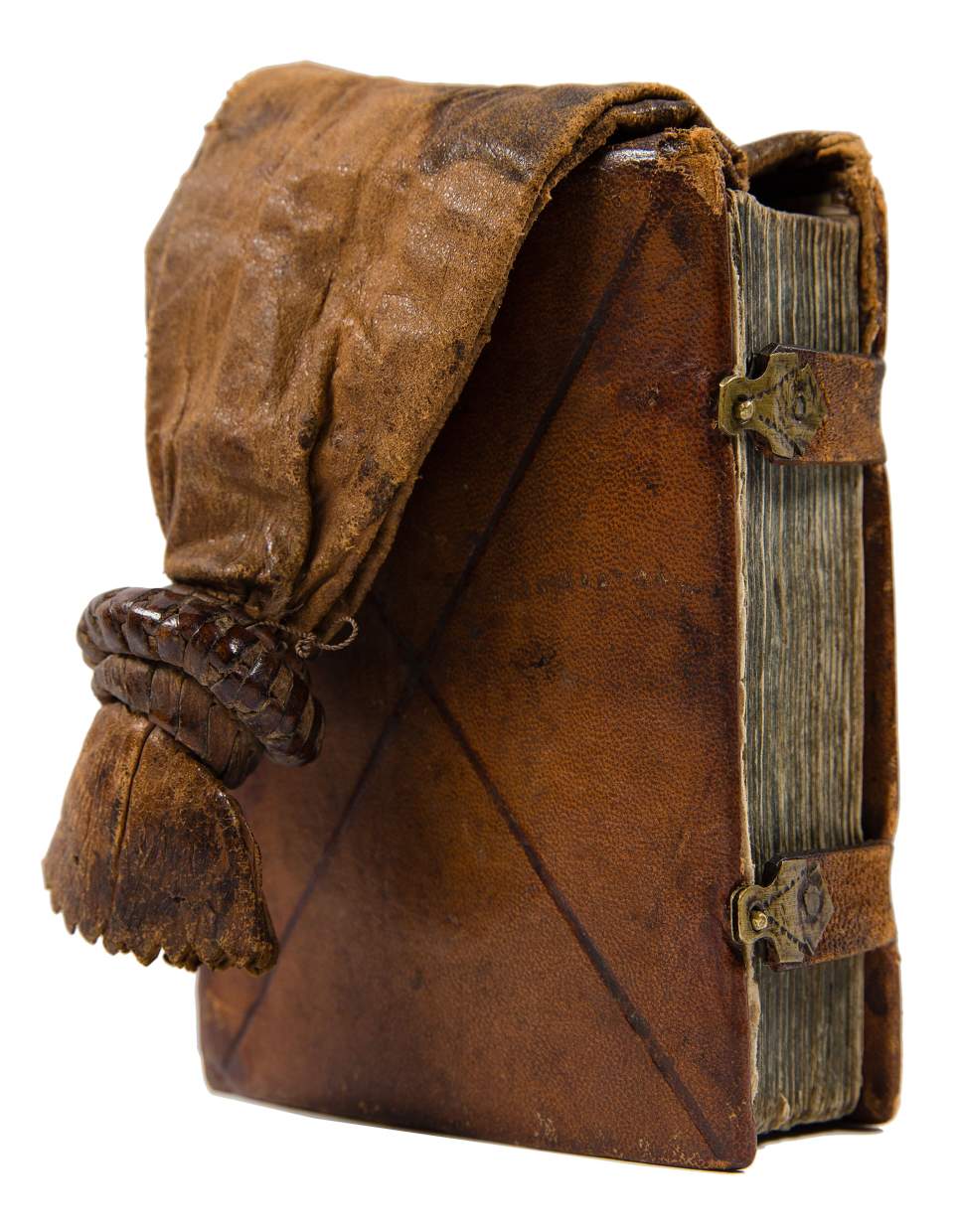-
Kunstwerke / Werke
 CloseKatharina Röder von RodeneckRöder von Rodeneck Beutelbuch, 1540Illuminierte Handschrift auf Papier. Einband in Kalbsleder mit langem Beutel, am oberen Ende ein runder Knopf, den man am Gürtel befestigen konnte (der zweite Einband, wohl 17. Jahrhundert, als Ersatz für einen älteren?).98 x 76 mm. – 206 Blätter, 5 lavierte Federzeichnungen, darunter Vögel, Schriftrollen, Wappen und Embleme, 1 Einzelblatt mit zeitgenössischer Miniatur auf Pergament eingefügt (fol. 9).Signiert von Katharina Röder von Rodeneck am Nikolaustag 1540 (fol. 205v).Hide caption
CloseKatharina Röder von RodeneckRöder von Rodeneck Beutelbuch, 1540Illuminierte Handschrift auf Papier. Einband in Kalbsleder mit langem Beutel, am oberen Ende ein runder Knopf, den man am Gürtel befestigen konnte (der zweite Einband, wohl 17. Jahrhundert, als Ersatz für einen älteren?).98 x 76 mm. – 206 Blätter, 5 lavierte Federzeichnungen, darunter Vögel, Schriftrollen, Wappen und Embleme, 1 Einzelblatt mit zeitgenössischer Miniatur auf Pergament eingefügt (fol. 9).Signiert von Katharina Röder von Rodeneck am Nikolaustag 1540 (fol. 205v).Hide caption
Röder von Rodeneck Girdlebook
Prayerbook, illuminated manuscript in German, written by Katharina Röder von Rodeneck.
Germany, Convent Frauenalb, completed on 6 December 1540.
98 x 76 mm, 206 leaves, 5 drawings in pen and wash, 1 miniature painted on vellum inserted.
ff. 2v-3: An owl clutching a heart in his talons; Death holding an hourglass and a scythe.
Hide caption
Röder von Rodeneck Girdlebook
Prayerbook, illuminated manuscript in German, written by Katharina Röder von Rodeneck.
Germany, Convent Frauenalb, completed on 6 December 1540.
98 x 76 mm, 206 leaves, 5 drawings in pen and wash, 1 miniature painted on vellum inserted.
ff. 3v-4: An owl holds the coats of arms of Thomas Röder von Rodeneck and Lucia von Sternenfels; A pigeon holds the coats of arms of Von Zeiskaim-von Remchingen and Nothaft von Hohenburg.
Hide caption Röder von Rodeneck BeutelbuchKatharina Röder von Rodeneck, Deutschland, Stift Frauenalb (bei Karlsruhe), 1540SoldDeutsches Gebetbuch, geschrieben von und für Katharina Röder von Rodeneck, einer Nonne des Klosters Frauenalb. Eines der sehr selten erhaltenen Beutelbücher, ein kleines Juwel, das heutigen Lesern einen Eindruck von der Atmosphäre des Mittelalters vermittelt.Signed by Katharina Röder von Rodeneck on St. Nicholas day 1540 (6 December, f. 205v).Illuminated manuscript in German, written on paper. Binding in a folded leather pouch with a knot, to loop over or slip under a belt (possibly secondary covering, 17th century?, replacing an older binding?).98 x 76 mm. – 206 leaves, with 5 drawings in pen and wash including birds, text-scrolls, coat of arms and devices/emblems, 1 miniature painted on vellum inserted (but contemporary) on a single leaf (f. 9).A small gem that transmits the ambiance of the Middle Ages to today's readersOverview
Röder von Rodeneck BeutelbuchKatharina Röder von Rodeneck, Deutschland, Stift Frauenalb (bei Karlsruhe), 1540SoldDeutsches Gebetbuch, geschrieben von und für Katharina Röder von Rodeneck, einer Nonne des Klosters Frauenalb. Eines der sehr selten erhaltenen Beutelbücher, ein kleines Juwel, das heutigen Lesern einen Eindruck von der Atmosphäre des Mittelalters vermittelt.Signed by Katharina Röder von Rodeneck on St. Nicholas day 1540 (6 December, f. 205v).Illuminated manuscript in German, written on paper. Binding in a folded leather pouch with a knot, to loop over or slip under a belt (possibly secondary covering, 17th century?, replacing an older binding?).98 x 76 mm. – 206 leaves, with 5 drawings in pen and wash including birds, text-scrolls, coat of arms and devices/emblems, 1 miniature painted on vellum inserted (but contemporary) on a single leaf (f. 9).A small gem that transmits the ambiance of the Middle Ages to today's readersOverviewA girdle book could be easily carried about. Often of small size, the codex itself was encased in a folded leather pouch that was worn suspended from a knot looped over or slipped under a belt where it would dangle until needed. The book-block was often sewn into the pouch upside-down so that the text could be read without detaching it. Such books are frequently seen in medieval paintings and sculptures but are extremely rare today. Only a total of 23 medieval girdle books have been preserved. The dark stained leather of the present manuscript suggests the book was often carried by its pouch.
Katharina Röder von Rodeneck finished writing on 6 December 1540 (f. 205v). She further added that she was professed on 21 November 1515 at the convent Frauenalb (f. 5v). The drawings include the coats of arms of Thomas Röder von Rodeneck and Lucia von Sternenfels, Katharina's parents. The Stift Frauenalb (south of Karlsruhe, Germany) housed mainly aristocratic daughters. Its grand ruins still are impressive today.
The rather personal prayers are divided over the days of the week and most of them end with references to pray the Pater Noster and Ave Maria. As various pages show some thumbing, wear and tear, Katharina used her book for which it was made, that is, for her own prayers and contemplation. The charming drawings and text scrolls, presumably all by the hand of Katharina Röder von Rodeneck herself, add considerable significance to the book.
This work is now in the collection of the Badische Landesbibliothek in Karlsruhe.
Röder von Rodeneck Girdlebook Prayerbook, illuminated manuscript in German, written on paper by the nun Katharina Röder von Rodeneck for her own use. Germany, Baden, Convent Frauenalb, near Karlsruhe-Pforzheim, completed on St. Nicholas day (December 6th), 1540



